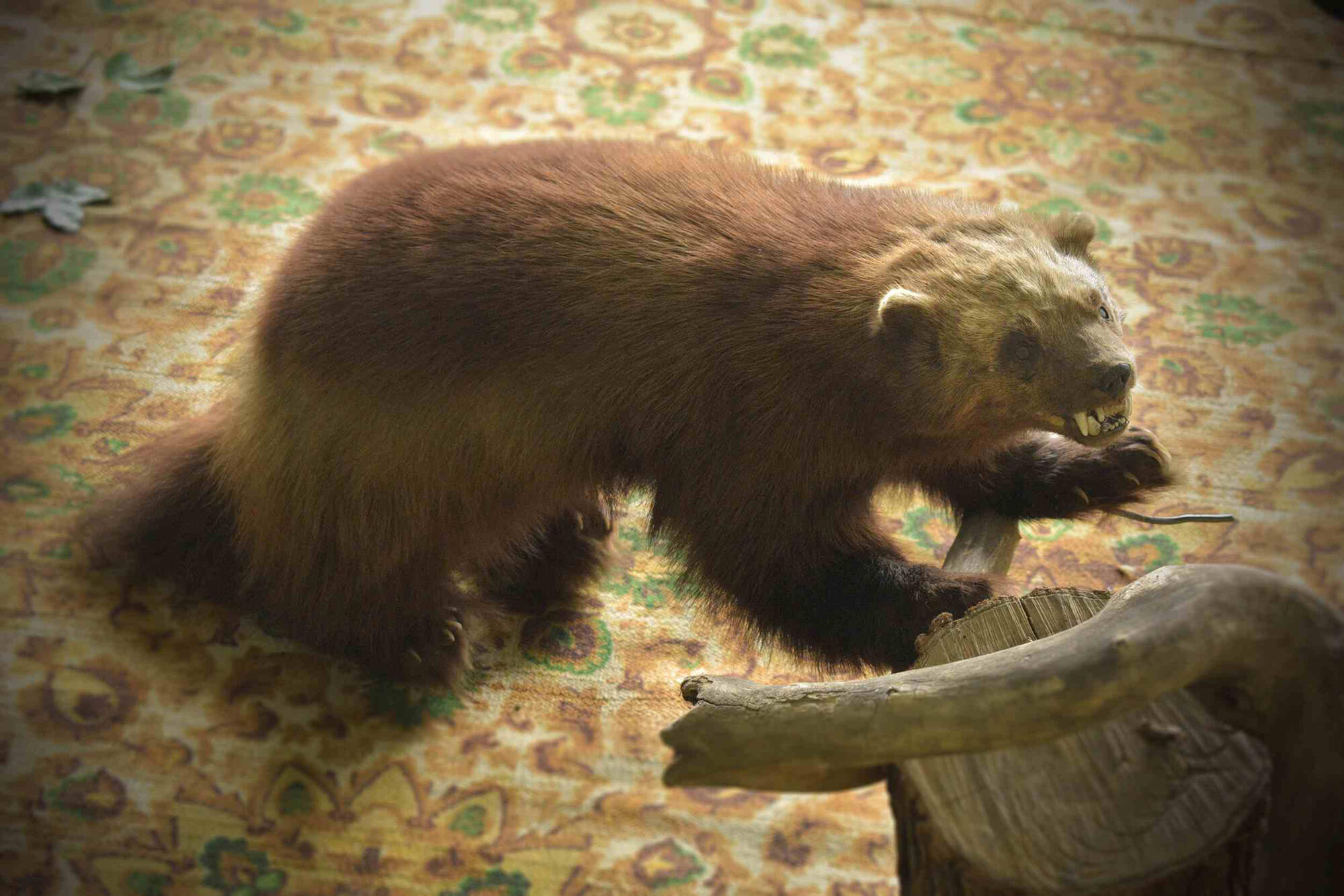The name of wolverines in Latin, ‘Gulo’, means ‘glutton’. At times, the animal is also called a skunk bear because of the odorous secretion produced by its anal musk glands.
The carcajou is a carnivore from the Mustelidae family. Among its members, it is viewed as a fairly large animal. A female’s weight can reach up to 10 kilograms, while that of a male — up to 15 kg. One can also encounter animals weighing up to 20 kilograms. The wolverine’s body, excluding its tail, measures from 70 to 95 centimeters. Its height, once grown, reaches up to 0.5 meters. The animal’s hind legs are much longer than the front ones, hence the outline of its body makes it look hunched. Its teeth are quite large with sharp as a razor edges. They are true weapons that really help the predator whenever it hunts. The wolverine’s jaws are very powerful, they can break apart even the smallest remnants of food.
Its coat can be dark chestnut, black or (rarely) light brown in color. The animal is not intimidated by either extremely cold temperatures or huge piles of snow. Its powerful legs help it get across any snow barriers. The carcajou digs large tunnels in the snow in order to reach its store chambers with its stocks. It can also hide in a pile of snow for several days.
The animal is more active at night than during daytime and sets off for its hunts at dusk. Its prey include small as well as fairly large animals. The wolverine has no qualms about eating the carrion of creatures killed by other predators. Weak and sick animals often fall prey to this carnivore. As an insatiable scavenger, it frees the environment of feeble animals and dead or decaying flesh. Wolverines can pursue their chosen prey for a very long time by tiring them out and sapping their energy. Zoologists have recorded instances when these animals traveled over a distance of more than 70 km without stopping.
They do not make permanent shelters. Wolverines can rest in many different places, i.e. between roots of large trees, in tree hollows and rock crevices. Only when this mammal is preparing to become a mother does it create something resembling a bear’s den. In the wild, under fairly harsh natural conditions, wolverines can live until the age of 10. In captivity, their lifespans substantially increase to up to 17 years. The carcajou does not have that many natural enemies, which include predators, such as wolves, lynxes and bears. Still, the latter rarely attack wolverines. Instead they try to avoid carcajous on account of the unusual smell of secretions they produce not only in order to mark their territories and attract partners of the opposite sex but also to frighten any potential enemies.
The carcajou is a carnivore from the Mustelidae family. Among its members, it is viewed as a fairly large animal. A female’s weight can reach up to 10 kilograms, while that of a male — up to 15 kg. One can also encounter animals weighing up to 20 kilograms. The wolverine’s body, excluding its tail, measures from 70 to 95 centimeters. Its height, once grown, reaches up to 0.5 meters. The animal’s hind legs are much longer than the front ones, hence the outline of its body makes it look hunched. Its teeth are quite large with sharp as a razor edges. They are true weapons that really help the predator whenever it hunts. The wolverine’s jaws are very powerful, they can break apart even the smallest remnants of food.
Its coat can be dark chestnut, black or (rarely) light brown in color. The animal is not intimidated by either extremely cold temperatures or huge piles of snow. Its powerful legs help it get across any snow barriers. The carcajou digs large tunnels in the snow in order to reach its store chambers with its stocks. It can also hide in a pile of snow for several days.
The animal is more active at night than during daytime and sets off for its hunts at dusk. Its prey include small as well as fairly large animals. The wolverine has no qualms about eating the carrion of creatures killed by other predators. Weak and sick animals often fall prey to this carnivore. As an insatiable scavenger, it frees the environment of feeble animals and dead or decaying flesh. Wolverines can pursue their chosen prey for a very long time by tiring them out and sapping their energy. Zoologists have recorded instances when these animals traveled over a distance of more than 70 km without stopping.
They do not make permanent shelters. Wolverines can rest in many different places, i.e. between roots of large trees, in tree hollows and rock crevices. Only when this mammal is preparing to become a mother does it create something resembling a bear’s den. In the wild, under fairly harsh natural conditions, wolverines can live until the age of 10. In captivity, their lifespans substantially increase to up to 17 years. The carcajou does not have that many natural enemies, which include predators, such as wolves, lynxes and bears. Still, the latter rarely attack wolverines. Instead they try to avoid carcajous on account of the unusual smell of secretions they produce not only in order to mark their territories and attract partners of the opposite sex but also to frighten any potential enemies.



